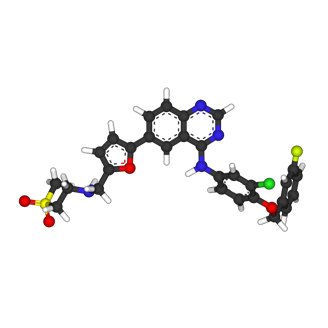Rash Could Signal Complete Response in Lapatinib-Treated HER2+ Breast Cancer
Women who developed a rash early in their treatment for HER2-positive breast cancer with lapatinib were more likely to go on to have pathologic complete response compared to those who did not get a rash, according to the results of an unplanned analysis of data from the NeoALTTO trial.
Ball-and-stick model of lapatinib

Women who developed a rash early in their treatment for HER2-positive breast cancer with lapatinib were significantly more likely to go on to have pathologic complete response compared to those who did not get a rash, according to the results of an unplanned analysis of data from the NeoALTTO (Neoadjuvant Lapatinib and/or Trastuzumab Treatment Optimisation) phase III trial.
“This study provides clear information on the pattern of lapatinib related side effects,” said study author Hatem A. Azim, Jr, MD, of the Institut Jules Bordet, Brussels, Belgium. “We found that patients developing rash have a higher chance of pathologic complete response, particularly those older than 50 years.”
Trials of other EGFR-targeting tyrosine kinase inhibitors have shown that skin rash can be an early sign of response and an indicator of better progression-free survival. Skin rash has been reported in trials of lapatinib, but no studies have analyzed if the rash is predictive of benefit due to lapatinib.
The NeoALTTO trial enrolled women with HER2-positive early breast cancer and randomly assigned them to treatment with lapatinib, trastuzumab, or both treatments combined for 6 weeks followed by paclitaxel for 12 weeks. For this unplanned analysis, the 306 patients assigned to lapatinib or the combination arm were included and the researchers looked at the pattern of rash, diarrhea, and hepatic adverse events and their association with age and response.
Azim and colleagues found that women aged 50 years or younger were significantly more likely to experience rash compared with older patients (74.4% vs 47.9%; P < .001). However, no differences in the rate of diarrhea and hepatic adverse events were found by different age groups.
The researchers found that development of early rash was independently associated with a higher chance of pathologic complete response only in women aged older than 50 (OR = 3.76; 95% CI, 1.69-8.34)
“As rash classically develops within 2 to 3 weeks, it can serve as an early sign to determine benefit of lapatinib,” Azim said.
Overall, 44.3% of patients who developed an early rash had pathologic complete response compared with 31.8% of patients who did not develop a rash. When the researchers isolated these data by age they found that 50% of women aged older than 50 years who developed rash had pathologic complete response compared with 26.6% of women with no rash. No similar difference in rate of complete response was found in women aged 50 years or younger.
“As pathologic complete response is a known surrogate for long-term outcome, our observation could be of high clinical relevance,” Azim said. “However it should be noted that this was an unplanned analysis and further validation is required to confirm these findings.”
Maintenance Tucatinib Combo Yields PFS Extension in Advanced HER2+ Breast Cancer
December 11th 2025“HER2CLIMB-05 has demonstrated that the addition of tucatinib to HP represents an enhanced frontline maintenance therapy option for patients with HER2-positive metastatic breast cancer,” said Erika Hamilton, MD.